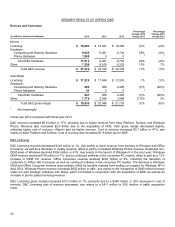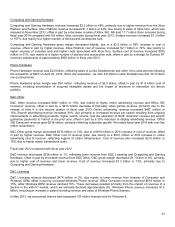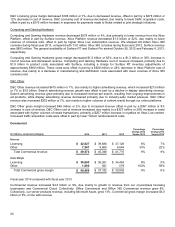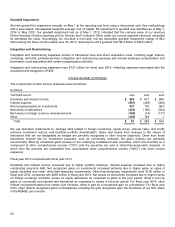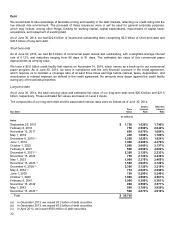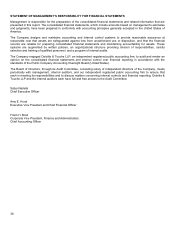Microsoft 2014 Annual Report Download - page 30
Download and view the complete annual report
Please find page 30 of the 2014 Microsoft annual report below. You can navigate through the pages in the report by either clicking on the pages listed below, or by using the keyword search tool below to find specific information within the annual report.
29
Fiscal year 2013 compared with fiscal year 2012
Dividends and interest income decreased due to lower yields on our fixed-income investments, offset in part by higher
average portfolio investment balances. Net recognized gains on investments decreased primarily due to lower gains on
sales of equity and fixed-income securities and a gain recognized on the partial sale of our Facebook holding in the prior
year, offset in part by lower other-than-temporary impairments. Other-than-temporary impairments were $208 million in
fiscal year 2013, compared with $298 million in fiscal year 2012. Net losses on derivatives decreased due to gains on
equity derivatives in the current fiscal year as compared with losses in the prior fiscal year, and lower losses on
commodity and foreign exchange derivatives as compared to the prior fiscal year, offset in part by losses on interest-rate
derivatives in the current fiscal year as compared to gains in the prior fiscal year. For the current year, other reflects
recognized gains on divestitures, including the gain recognized upon the divestiture of our 50% share in the MSNBC joint
venture.
INCOME TAXES
Fiscal year 2014 compared with fiscal year 2013
Our effective tax rate for fiscal years 2014 and 2013 was approximately 21% and 19%, respectively. Our effective tax rate
was lower than the U.S. federal statutory rate primarily due to earnings taxed at lower rates in foreign jurisdictions
resulting from producing and distributing our products and services through our foreign regional operations centers in
Ireland, Singapore, and Puerto Rico.
Our fiscal year 2014 effective rate increased by 2% from fiscal year 2013 mainly due to adjustments of $458 million to
prior years’ liabilities for intercompany transfer pricing that increased taxable income in more highly taxed jurisdictions, as
well as losses incurred by NDS and changes in the geographic mix of our business. This was offset in part by favorable
transfer pricing developments in certain foreign tax jurisdictions, primarily Denmark.
Changes in the mix of income before income taxes between the U.S. and foreign countries also impacted our effective tax
rates and resulted primarily from changes in the geographic distribution of and changes in consumer demand for our
products and services. We supply our Windows PC operating system to customers through our U.S. regional operating
center, while we supply the Microsoft Office system and our server products and tools to customers through our foreign
regional operations centers. Windows PC operating system revenue decreased $655 million in fiscal year 2014, while
Microsoft Office system and server products and tools revenue increased $1.3 billion and $1.6 billion, respectively, during
this same period. In fiscal years 2014 and 2013, our U.S. income before income taxes was $7.1 billion and $6.7 billion,
respectively, and comprised 26% and 25%, respectively, of our income before income taxes. In fiscal years 2014 and
2013, the foreign income before income taxes was $20.7 billion and $20.4 billion, respectively, and comprised 74% and
75%, respectively, of our income before income taxes.
Tax contingencies and other tax liabilities were $10.4 billion and $9.4 billion as of June 30, 2014 and 2013, respectively,
and are included in other long-term liabilities. This increase relates primarily to adjustments to prior years’ liabilities for
intercompany transfer pricing and adjustments related to our IRS audits. While we settled a portion of the I.R.S. audit for
tax years 2004 to 2006 during the third quarter of fiscal year 2011, we remain under audit for those years. In February
2012, the I.R.S. withdrew its 2011 Revenue Agents Report and reopened the audit phase of the examination. As of
June 30, 2014, the primary unresolved issue relates to transfer pricing which could have a significant impact on our
consolidated financial statements if not resolved favorably. We have not received a proposed assessment for the
unresolved issues and do not expect a final resolution of these issues in the next 12 months. Based on the information
currently available, we do not anticipate a significant increase or decrease to our tax contingencies for these issues. We
also continue to be subject to examination by the I.R.S. for tax years 2007 to 2013.
We are subject to income tax in many jurisdictions outside the U.S. Our operations in certain jurisdictions remain subject
to examination for tax years 1996 to 2013, some of which are currently under audit by local tax authorities. The
resolutions of these audits are not expected to be material to our consolidated financial statements.
Fiscal year 2013 compared with fiscal year 2012
Our effective tax rate for fiscal years 2013 and 2012 was approximately 19% and 24%, respectively. Our effective tax rate
was lower than the U.S. federal statutory rate primarily due to earnings taxed at lower rates in foreign jurisdictions
resulting from producing and distributing our products and services through our foreign regional operations centers in
Ireland, Singapore, and Puerto Rico.





